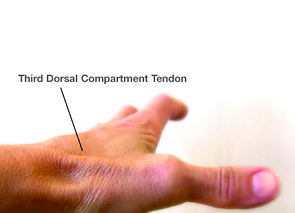De Quervain's Tendonitis
-
Pain with thumb motion
-
Can be treated with a steroid injection at your visit
-
Surgery can provide a permanent fix - often performed in the office and only takes minutes
What is De Quervain's thumb tendonitis?

Patients with de Quervain’s Tenosynovitis have painful tendons on the thumb side of the wrist. Tendons are the rope-like structures that the muscle uses to pull the bone. You can see them on the back of your hand when you straighten your fingers.
In de Quervain’s Tenosynovitis, the tunnel (the first extensor compartment; see figures 1A and 1B) where the tendons run can narrow, or the tendons can take up extra space in the tunnel. This can be due to a thickening of the soft tissues that make up the tunnel or an increase in the amount of soft tissue within the tunnel. In this condition, hand and thumb motion can cause pain, especially with forceful grasping or twisting.
Causes
Doctors are not sure what causes de Quervain’s Tenosynovitis, but changes in the use of the hand may be a cause. Repetitive movements, changes in hormones, and swelling are likely factors. When new mothers develop this condition, it typically appears 4 to 6 weeks after delivery.
Signs and Symptoms
Patients with de Quervain’s Tenosynovitis often describe a feeling of sharp or dull pain and swelling. This is either at the base of the thumb or at the wrist. People of all ages can experience these problems.
Treatment
Treatments that can relieve symptoms include:
-
A splint that stops you from moving your thumb and wrist
-
Tylenol or anti-inflammatory medications (e.g., Ibuprofen)
-
A cortisone-type of steroid injection into the tendon compartment (Response to these injections varies, but they can sometimes be successful long-term.)
If these less-invasive options have not provided relief, surgery to open the tunnel and make more room for the tendons may be considered. Discuss the best treatment option for you with your hand surgeon.
© 2017 American Society for Surgery of the Hand


